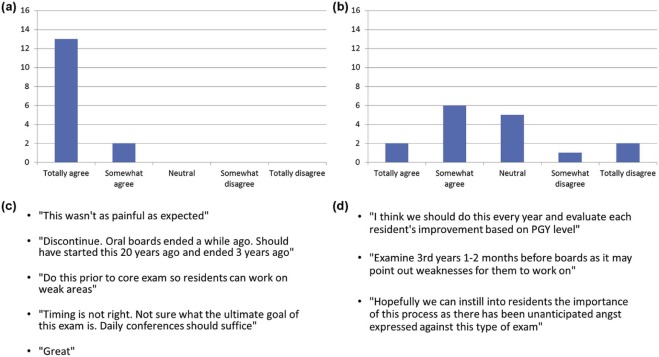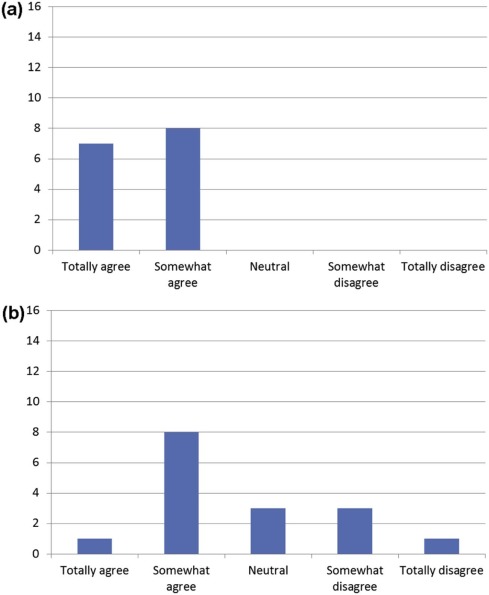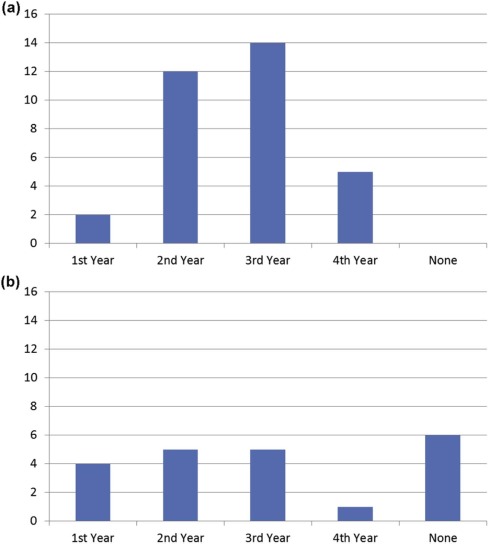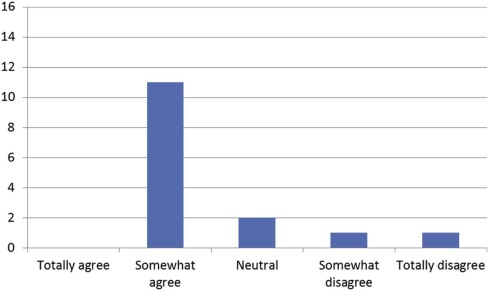Rationale and Objectives
The American Board of Radiology has adopted a new standardized board examination and the traditional oral examination has been abandoned. Although many programs have changed their educational efforts to reflect the new test format, some faculty members and residents have expressed a desire to keep an oral examination as a component of education and evaluation in radiology residency programs.
Materials and Methods
An oral comprehensive examination including all the appropriate subspecialties was administered to each second year and third year resident in our training program by faculty members. Both the resident examinees and faculty examiners were surveyed after the examination to gauge the perceived value of the experience.
Results
Residents were divided in their perceptions of the fairness and utility of an oral examination as a tool to aid in board preparation and as an assessment of their knowledge and communication skill. Faculty members were universal in their endorsement of the oral examination and suggested continued use of the technique.
Conclusions
Residents and faculty members have differing perceptions of an oral examination delivered during training to assess knowledge and communication skill. The value of an oral examination in providing actionable feedback to trainees and the possibility of detecting struggling residents made it useful in our training program, and it thus it has been implemented for future years. Whether resident performance measured by this technique is predictive of success on American Board of Radiology examinations remains unclear.
Introduction
Radiology residency programs have undergone significant changes in their approach to board preparation with the advent of the American Board of Radiology (ABR) computerized Core Examination, which was introduced in 2013. Traditionally, oral examinations and case-based reviews have been a major component of board preparation and continue to be used by residency programs. The most recent survey of academic chief residents shows a continued reliance on internal board review preparation, with 81% of programs incorporating this approach . The use of a mock oral board examination to assess fund of knowledge and communication was common in years past but seems to be less so with the changed board examination format. Detailed descriptions of how best to conduct a mock radiology oral examination exist in the literature and have served as the template for similar exercises performed at many training programs, including University of Colorado. In addition to preparing residents for a high-stakes oral assessment of their medical knowledge by replicating the experience of being shown cases with little or no guidance, the mock board examination also focused on how to “take a case” and is reflective of what radiologists do in clinical practice. At our institution before the new ABR examination format change, mock oral examinations were given to members of the second, third, and fourth year classes each year. Although the examination served as a final preparation for most senior residents, it was a useful way to generate feedback to the more junior participants and for the program to identify struggling trainees.
A growing perception in our program has been that it is increasingly difficult to identify residents in need of remediation, and a cohesive style of communication when describing cases in conference was lacking among junior residents. In years past, this skill developed in junior residents as they modeled these skills from their more senior resident colleagues. For the reasons described above, we set out to revisit the notion of having a formal comprehensive oral examination to recapture the benefits that this process had brought to the program and residents in years past.
Materials and Methods
Get Radiology Tree app to read full this article<
Get Radiology Tree app to read full this article<
Get Radiology Tree app to read full this article<
Get Radiology Tree app to read full this article<
Get Radiology Tree app to read full this article<
Results
Get Radiology Tree app to read full this article<
Get Radiology Tree app to read full this article<
Get Radiology Tree app to read full this article<
Get Radiology Tree app to read full this article<
Get Radiology Tree app to read full this article<
Get Radiology Tree app to read full this article<
Get Radiology Tree app to read full this article<
Get Radiology Tree app to read full this article<
Discussion
Get Radiology Tree app to read full this article<
Get Radiology Tree app to read full this article<
Get Radiology Tree app to read full this article<
Get Radiology Tree app to read full this article<
Get Radiology Tree app to read full this article<
References
1. Hammer M.M., Shetty A.S., Cizman Z., et. al.: Results of the 2015 survey of the American Alliance of Academic Chief Residents in Radiology. Acad Radiol 2015; 22: pp. 1308-1316.
2. Khan F.A., Bhalla S., Jost R.G.: Results of the 2001 survey of the American Association of Academic Chief Residents in Radiology. Acad Radiol 2002; 9: pp. 89-97.
3. Canon C.L., Mulligan S., Koehler R.E.: Mock radiology oral examination. Acad Radiol 2005; 12: pp. 368-372.
4. Accreditation Council for Graduate Medical Education (ACGME) : The Diagnostic radiology milestone project. ACGME website. Published July; Available at https://www.acgme.org/Portals/0/PDFs/Milestones/DiagnosticRadiologyMilestones.pdf
5. Rozenshtein A., Heitkamp D.E., Muhammed T.L., et. al.: “What Program Directors Think” III: results of the 2014/2015 annual surveys of the Association of Program Directors in Radiology (APDR). Acad Radiol 2016; 23: pp. 861-869.
6. Hollingsworth C.L., Wriston C.C., Bisset G.S., et. al.: American Board of Radiology certifying examination: oral versus computer-based format. AJR Am J Roentgenol 2010; 195: pp. 820-824. [Comparative Study Research Support, Non-U.S. Gov’t]
7. Pressman B.D., Hoffman T.R.: ACR white paper: task force on timing of oral boards in diagnostic radiology. J Am Coll Radiol 2008; 5: pp. 1112-1117.
8. Becker G.J., Bosma J.L., Guiberteau M.J., et. al.: ABR examinations: the why, what, and how. Radiology 2013; 268: pp. 219-227.
9. Aboulian A., Schwartz S., Kaji A.H., et. al.: The public mock oral: a useful tool for examinees and the audience in preparation for the American Board of Surgery Certifying Examination. J Surg Educ 2010; 67: pp. 33-36.



